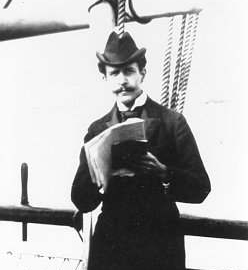E. M. Antoniadi facts for kids
Quick facts for kids
Eugène Michel Antoniadi
|
|
|---|---|

Eugène Michel Antoniadi
|
|
| Born | 1 March 1870 |
| Died | 10 February 1944 (aged 73) |
| Nationality | Greek-French |
| Occupation | Astronomer |
| Years active | 1893–1944 |
| Known for | Maps of Mars and Mercury |
|
Notable work
|
La planète Mars, 1659-1929 |
Eugène Michel Antoniadi (Greek: Ευγένιος Αντωνιάδης; March 1, 1870 – February 10, 1944) was a Greek-French astronomer. He was famous for his detailed maps of the planets Mars and Mercury. He also created a special scale to measure how clear the sky is for observing planets.
Contents
Life of an Astronomer
Eugène Antoniadi was born in Istanbul (which used to be called Constantinople). He later moved to France and spent most of his life there. A famous astronomer named Camille Flammarion invited him to France.
Early Career
Antoniadi became part of important astronomy groups. In 1890, he helped start the British Astronomical Association (BAA). He later became a Fellow of the Royal Astronomical Society in 1899.
He was very interested in the planet Mars. In 1892, he joined the BAA's Mars Section. He even became the director of that section in 1896. He also joined the French Astronomical Society (SAF) in 1891.
Working at Observatories
Camille Flammarion hired Antoniadi in 1893. He worked as an assistant astronomer at Flammarion's private observatory in Juvisy-sur-Orge. Antoniadi worked there for nine years. In 1902, he left that observatory and the SAF.
Antoniadi rejoined the SAF in 1909. That same year, he got a special chance. Henri Deslandres, who was the director of the Meudon Observatory, let him use a very powerful telescope. This was the Grande Lunette, an 83-centimeter (33-inch) Great Refractor.
Observing Planets
Antoniadi became a highly respected observer of Mars. At first, he believed in the idea of "Martian canals." These were thought to be channels built by intelligent life on Mars.
However, after using the huge 83-centimeter telescope at Meudon Observatory in 1909, he changed his mind. He realized that these "canals" were actually an optical illusion. This means they were just tricks of light or how our eyes see things. He also spent time observing Venus and Mercury.
He created the first map of Mercury. But his maps had a small problem. He incorrectly thought that Mercury always showed the same side to the Sun. This is called synchronous rotation. We now know this is not true for Mercury.
Antoniadi also made a very important contribution to astronomy. He created the first standard names for the dark and light areas on Mars. The International Astronomical Union (IAU) officially adopted 128 names from his 1929 map called La Planète Mars.
Other Interests
Antoniadi is also famous for creating the Antoniadi scale of seeing. This scale helps astronomers measure how clear the sky is. It tells them how steady the air is, which affects how well they can see planets and stars. Many amateur astronomers still use this scale today.
Besides astronomy, he was also a very strong chess player. In 1907, he tied for first place with Frank Marshall in a tournament in Paris. He even finished ahead of another famous player, Savielly Tartakower.
Eugène Antoniadi passed away in Paris when he was almost 74 years old.
What's in a Name?
His full name was Eugène Michel Antoniadi. In Greek, it is Ευγένιος Μιχαήλ Αντωνιάδης. Sometimes, people also called him Eugenios Antoniadis. You might also see his name written as Eugène Michael Antoniadi.
Awards and Honors
Eugène Antoniadi received several awards for his work:
- 1925 – He won the Prix Jules Janssen from the French Astronomical Society.
- 1926 – He received the Prix Guzman of 2,500 Francs from the Académie des Sciences.
- 1932 – He was awarded the Prix La Caille from the Académie des Sciences.
Some places in space are named after him to honor his contributions:
- 1970 – The Antoniadi crater on the Moon was named after him by the International Astronomical Union.
- 1973 – The Antoniadi crater on Mars was named after him by the International Astronomical Union.
- 1976 – The Antoniadi Dorsum (a type of ridge) on Mercury was named after him by the International Astronomical Union.
See also
- Demetrios Eginitis
 In Spanish: Eugène Antoniadi para niños
In Spanish: Eugène Antoniadi para niños


